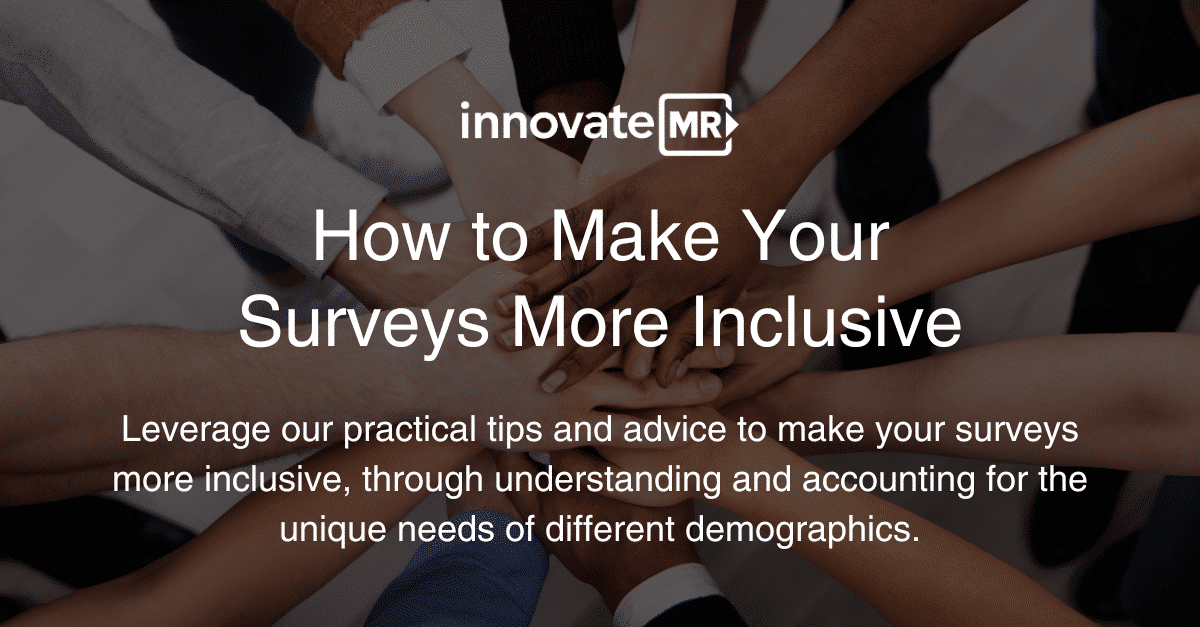
Introduction
The overall goal of market research is to gather insights from communities, elevate their voices, and use that data to make informed decisions that better serve them. An inclusive approach to market research helps businesses better understand their target audience, allowing them to tailor their products and services to meet their unique needs. Additionally, participating in surveys can be a powerful way for marginalized groups to make their voices heard and prioritized in the corporate sphere, leading to more meaningful and accurate results for clients, and better products and services for a wider range of audiences.

What are Inclusive Demographics?
Inclusive demographics most commonly include gender, sex, race, and ethnicity but can also have age, sexual orientation, disability, income, education level, and other factors. It can help pinpoint how different social and economic characteristics intersect to form populations and target demographics. Providing inclusive demographics throughout survey fielding can provide valuable insight to researchers and organizations on better serving a particular population.
Why are Inclusive Demographics Important in Market Research?
Inclusive demographics are essential in market research because they ensure representation for all potential consumers, validate the needs of underrepresented communities, and confirm that the data gathered reflects a larger population.
Diverse data sets can also reveal valuable insights about racial segments, their consumer behaviors, and values. An inclusive demographic representation in market research data can also help build brand trust, as consumers can feel seen and heard. Most importantly, by having inclusive surveys, a brand displays that they care about its consumers, which can drive brand engagement, loyalty, and revenue returns in the long term.
Now that you know the importance of inclusive demographics and how they can benefit both your research projects and your business, here is how to make your surveys more inclusive:
Transparency
Many privacy laws require research firms to provide a clear explanation of the purpose of their survey and the intentions for the data. Doing so will ensure that your participant understands your intentions with their often-personal information. In addition, being transparent creates an environment of trust and respect as well as an inclusive environment because your participant feels more empowered to help you achieve your research goal.
Research and Awareness
Researchers must be aware of the complexities of inclusive demographics. For example, a study participant could identify using ten different personal variables. Researchers need to understand the nuances of asking demographic questions. For example, the designation of gender can differ from what an individual considers as their gender identity. Researchers can dig a little deeper by asking what gender was assigned at birth and following up with a question on how they identify. When participants don’t see their gender as one of the options, it can skew results negatively or even cause that participant to drop completely, leaving you unable to capture their responses. Awareness of the language and phrasing used in questions is incredibly important. This requires using inclusive, informed language rather than assumptions or even slang to appeal to a specific demographic. It is best practice to avoid terms and vernaculars that could be interpreted in a different context by a diverse group of people.
Another resource is the Multicultural Insights Collective, which is a group of research, media, and educational professionals that work together to empower businesses to conduct effective research on diversity, equity, and inclusion topics. The MIC, formed in partnership with Lisa Wilding-Brown, CEO of InnovateMR, is focused on opening channels of communication across the research industry and generating real change. In one of their webinars, “How Words Matter for the Future of Work,” the team discusses ways to effectively research and implement inclusive and multicultural initiatives.

Accessibility is Key
It is important to consider how accessible your survey is throughout planning and fielding. Your ideal participant may not have a desktop computer and may only be able to complete surveys on their mobile device. Providing the ability to complete your survey on various platforms, such as mobile devices, tablets, as well as computers, is an efficient tactic to implement when designing your research project.
Additionally, clear and concise language in your questionnaire lowers any potential misinterpretation of your survey. If your survey targets an audience with a language different from yours, utilize translation services to provide it in multiple languages, as respondents may feel more comfortable answering questions and provide more robust informed responses in their primary language.
It is important to also make your survey easy to navigate and understand by using appropriate color contrast and user-friendly design elements to make your survey widely digestible. Steer away from vibrant reds, blues, yellows, or greens that are required to fully understand the context of a question – when in doubt, keep it simple.
Finally, implement reasonable accommodations for individuals with disabilities so they can easily access and complete your survey. These accommodations can range from one-on-one interviews versus a panel interview or text-to-audio options for visually impaired participants. Providing options that make your survey easy to take and widely accessible increases your response rate, enabling you to reach your target audience more easily and faster.

Consider Different Types of Questions and Inclusive Screeners
Researchers must assess whether having inclusive demographic data is needed to accomplish the goal of the study. Tailoring the questions to your research objectives ensures you get the most accurate insights for your study. Instead of limiting demographic questions, try allowing participants to select from multiple options. This tailors their experience to different demographic groups and can help paint a more concise picture. Including multiple-select questions allows participants to choose the option that best fits their experiences, and open-ended questions can enable participants to respond freely, providing accurate and detailed answers that genuinely capture their opinions. Using a mix of inclusive demographic questions paired with diverse answer alternatives allows respondents to feel listened to, respected, and included regardless of their background or beliefs.
A study conducted by the Insight’s Associations IDEA Council tested ten different race/ethnicity question formats amongst 4,892 US respondents. An implicit and explicit test was also run to determine positive and negative feelings to questions based on participants’ response times. There was an overwhelmingly positive response when participants were asked about their race. However, there was a small percentage that (identified as either Black/African American, Multiple races or Another race/ethnicity, younger (Gen Z or Millennial), or that take less surveys), felt upset (1 in 4), and/or offended (1 in 7), when asked the same question. This proves the need for a more inclusive and sensitive approach to demographic questions. The question types that performed best were, census-like single descriptive select all replies, descriptive single select all replies and descriptive select all with Asian and Hispanic Follow Up. The study highlighted the importance of more closely considering if your screeners are necessary to achieve the objective of your study and that it is best to provide descriptive options, the ability to combine ethnicity and race selections as well as multiple selections in your screener questions.
Allowing Participants to Skip and Leave Questions Unanswered
Another way to make your survey more inclusive is by providing the option to skip questions or select “I prefer not to answer.” Doing so ensures that participants feel comfortable and respected throughout the interview process. By allowing them to skip questions, participants don’t feel obligated to answer questions that may invoke feelings of vulnerability, judgment, and discomfort. Having this option increases the likelihood that you’re collecting accurate and relevant data and can also improve your survey completion rates because your participant is less likely to drop out. Researchers want their participants to feel comfortable and respected, and this answer choice provides unique insights in and of itself. Using skip logic to move participants through the survey depending on their answer selections ensures a more inclusive, safe environment for your participants.

Conclusion
Using inclusive demographics in your survey projects offers the potential for a better representative look at your target audience, improves response rates, and increases both the quantity and quality of responses from minority audiences.
Remember to be transparent about your goals and communicate how you will use the data with your audience. Make your survey accessible, with multiple question types and answer options, to allow your survey to reach a broader demographic. Utilizing these steps will ensure you obtain accurate data to achieve your research objectives.
In conclusion, implementing inclusive demographic tactics in your research projects keeps your participants engaged and increases the reliability and validity of your survey, providing an overall accurate representation of your target population.
About InnovateMR – InnovateMR is a full-service sampling and ResTech company that delivers faster, quality insights from business and consumer audiences utilizing cutting-edge technologies to support agile research. As industry pioneers, InnovateMR provides world-class end-to-end survey programming, targeted international sampling, qualitative and quantitative insights, and customized consultation services to support informed, data-driven strategies, and identify growth opportunities. Known for their celebrated status in customer service and results, InnovateMR combines boutique-level service with extensive global reach to achieve partner success.


